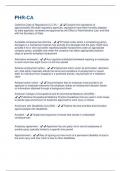EMT FISDAP Paramedic Entrance Exam
1. What part of the body should you lift with
ANS Legs
2. What is the purpose of QI
ANS Identify aspects of the system that could be improved. Not meant as a
disciplinary action
3. What are the five emotional stages of loss acceptance
ANS Denial, Anger, Bargaining, Depression, Acceptance
4. What is caused by a delayed stress reaction
ANS PTSD
5. What is caused by a cumulative stress reaction
1/9
, ANS Burnout
6. What is the primary method used to protect yourself
ANS PPE
7. What is standard PPE used for every call
ANS Gloves
8. What are the signs of death
ANS Absence of a pulse, complete unresponsiveness to any stimuli, no eye
movement or pupil response, Absence of blood pressure, no reflexes.
9. What are the obvious signs of death
ANS Decapitation, rigor mortis, decomposi- tion of the body, dependent lividity
10. How far away from your face should you hold the microphone
ANS 2 inches
2/9
,11. What is the medical term for swayback
ANS Lordosis
12. What is the medical term for slouch or hunchback
ANS Kyphosis
13. Define posterior:
ANS Toward the back of the body (opposite of anterior)
14. Define anterior
ANS: toward the front of the body
15. What are the three types of joint mobility
ANS immovable, slightly movable, freely movable
16. What are the different regions of the spine called
ANS Cervical, Thoracic, Lum- bar, Sacrum, Coccyx
3/9
,17. Which parts of the spine are fused together
ANS Sacrum and Coccyx
18. How many cervical vertebrae are there
ANS 7
19. How many thoracic vertebrae are there
ANS 12
20. How many lumbar vertebrae are there
ANS 5
21. How may vertebrae are there
ANS 33
22. How many sacral vertebrae are there
ANS 5 fused
4/9
,23. How many vertebrae are in the Coccyx
ANS 4 fused
24. What are the three types of muscle ANS skeletal, cardiac, smooth
25. Which type of muscle is voluntary ANS skeletal muscle
26. Which type of muscle is found only in the heart ANS cardiac muscle
27. Which type of muscle is found in the vessels and intestines ANS Smooth
muscle
28. What structures make up the upper airway ANS Nares (nostrils), Mouth and
oral cavity, Pharaynx, Larynx
29. What structures make up the lower airway ANS Trachea, Bronchi,
Bronchioles, Alveoli
5/9
, 30. What structure marks the end of the upper airway and the beginning of the
lower airway ANS Cricoid Cartilage
31. What is a thin layer of fluid that covers the alveoli ANS Surfactant
32. What muscles are involved in inspiration ANS diaphragm and external
inter- costals
33. What is the order of structures that blood circulates through ANS Right
atrium, right ventricle, pulmonary artery, pulmonary capillary, pulmonary vein,
left atrium, left ventricle, aorta, arteries, arterioles, capillaries, venules, veins,
vena cava, right atrium.
34. What structures is present in vain that prevents the backflow of blood ANS -
valves
35. What makes up the CNS ANS brain and spinal cord
36. What makes up the PNS ANS Nerves located outside the spinal column.
37. Which endocrine gland controls the other endocrine gland ANS pituitary
38. Which gland secretes adrenaline ANS adrenal gland
39. Which gland releases insulin ANS pancreas
6/9





